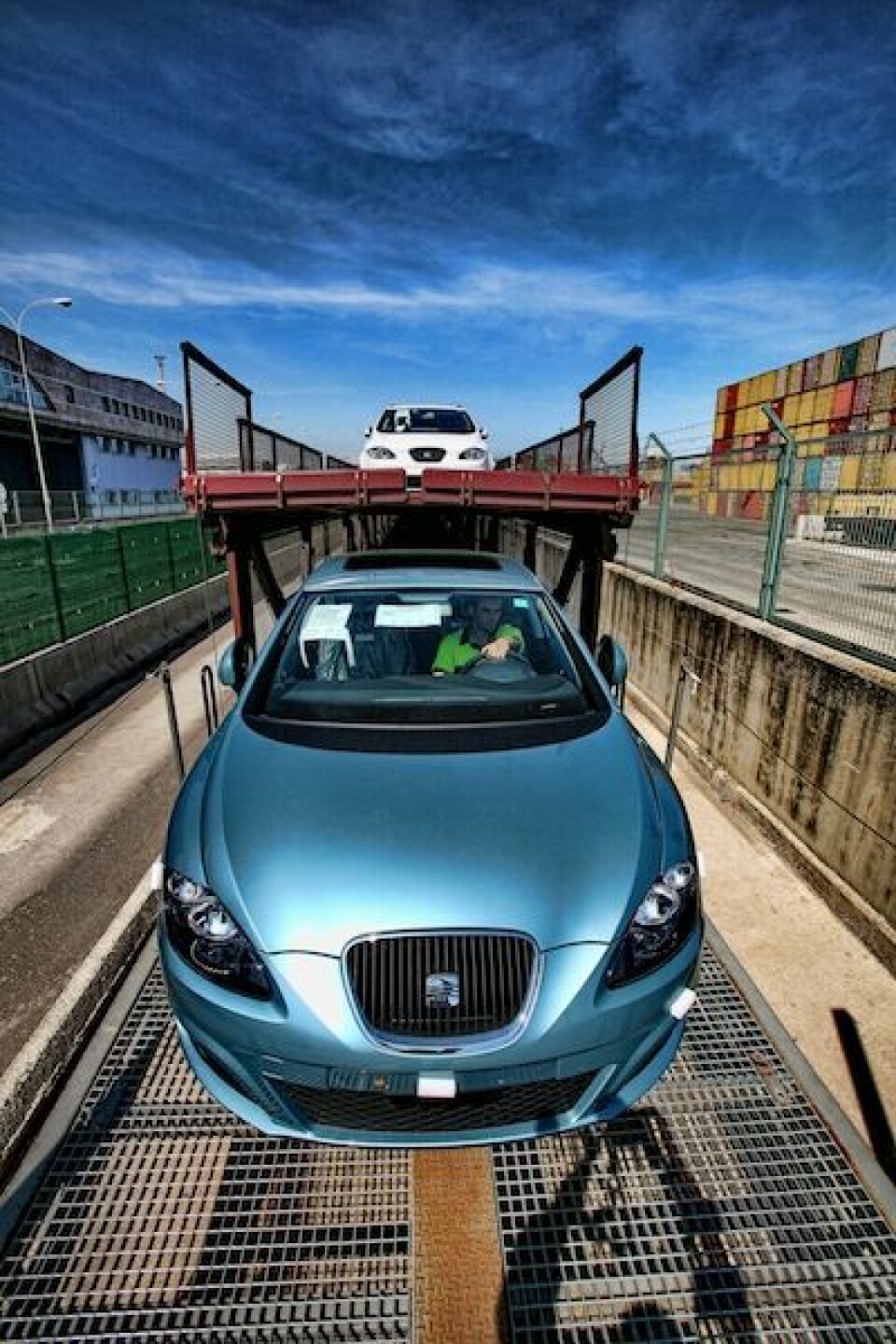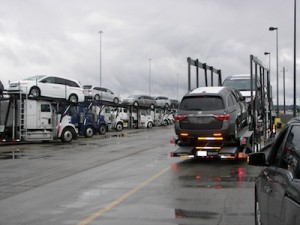ePOD – Delivering the future of proof
Chrysler’s decision to mandate the use of electronic proof of delivery systems from this year has brought the process to the fore, but an industry standard may be required before everyone follows suit.

At the beginning of February 2014, a new transport management system went live at Mobile Services, a UK-based car transport specialist responsible for moving approximately 2,500 vehicles a week for customers such as Jaguar Land Rover, Ford, and British car supermarket Motor Point.
Sourced from compound management software specialist Vehnet, the new system was implemented on the Jaguar Land Rover contract to begin with and slated to be rolled out across all Mobile Services’ contracts from the beginning of April.
“We’ve experienced a period of strong growth and realised that along with expanding our premises and recruiting more staff, we needed a more robust and flexible IT system to cope with increased service demands,” explains Mobile Services transport manager Dave Williams.
By “increased service demands”, Williams means the growing requirement for an alternative to the use of traditional paper-based documentation at the point of vehicle handover, a technology commonly referred to as ‘electronic proof of delivery’ (ePOD).
According to Vehnet managing director Steve Jones, ePOD is built in as a selectable option within the firm’s recently-launched transport management system, which features a graphical map interface that shows orders, fleet location and journey plans, and allows for real-time GPS tracking and integration with customers’ own systems. Both Mobile Services and Vehnet, he relates, were surprised at the degree of customer enthusiasm for ePOD, which has greatly exceeded initial expectations.
“The initial assumption was, in fact, that Jaguar Land Rover wouldn’t want ePOD,” he notes. “After Mobile Services then discovered that their major customer, Motor Point, also didn’t want paper delivery documentation if they could have ePOD instead, the die was pretty much cast.”
This is a discovery being echoed around the world of finished vehicle logistics. Suddenly, ePOD has become affordable and achievable, with both carmakers and finished vehicle logistics service providers now scrambling to catch up.
“Historically, automakers have wanted ePOD, but wanted to get it for free, bundled-in as part of the transport service,” observes Jones. “Carriers have always resisted that because profit margins were too tight, but with the costs of ePOD coming down, opinions have changed: ePOD is achievable on a low-cost Android device, if that’s what organisations want to do.”
Gaining momentum after a slow start
It is not that such paperless technology is a new discovery or breakthrough, so much as it is now starting to reach a critical mass in the outbound sector. Indeed, for some manufacturers, especially for inbound logistics, ePOD-like processes have been in place for a number of years. For outbound, Spain’s Seat has had ePOD technology in place for about ten years, while OEMs elsewhere in Europe as well as India have also adopted it.
“Technology-wise, ePOD isn’t very special, and the technical ability has been there for years,” says Matthias Berlit, vice-president of manufacturing logistics at software provider Inform, which has recently added an ePOD capability to its offering. “On the inbound side, customers of ours such as Mercedes and Volkswagen have been using smartphones to record the pickup of material from suppliers for some time. Conceptually, there is very little difference between that and outbound ePOD.”
Sovereign Integration Group, too, has added ePOD functionality to its EML finished vehicle logistics suite, via a rugged DataLogic handheld device. The UK-based software firm reports strong customer interest, including a major, but unnamed vehicle industry insurance group using the devices for damage handling and claims management.
After a slow start over recent years, ePOD now looks set to transform many aspects of finished vehicle logistics, and not only at the point of final delivery to the dealer or fleet owner. Extended through the supply chain, ePOD has the potential to impact vehicle tracking, damage claims handling, inspection checklists, invoicing and cash flow.
No wonder, then, that ePOD technology is gaining traction, albeit slowly; the fact that a number of major carmakers are moving towards it does seem to be helping, but issues still remain about its cost, how to evaluate and validate processes, and finally, what the overall benefits will be.

Chrysler leads the way
Talk to those close to the issue and it’s clear that an undoubted stimulus to ePOD adoption has been the decision by Chrysler to mandate its usage within its own finished vehicle supply chain. Dealer, carrier or other service provider, it makes no difference: ePOD will be obligatory from July 2014.
“The auto industry is one of the few industries that is currently not taking full advantage of technology in regards to delivery transactions,” observes Erika Mercado-Gratton, damage prevention and claims manager at Chrysler. “As I describe ePOD to individuals, their first reaction is generally to say: ‘Oh, you mean like when you get a delivery from UPS or FedEx?’ The mystery is more in the name ‘ePOD’ than the actual transaction itself.”
Chrysler’s logic in finally kick-starting ePOD usage within the industry is basic: by replacing labour-intensive paper systems with digital data, ePOD not only speeds the handover transaction, but adds value in ways that paper cannot.
“[ePOD] offers efficiency gains for both the carrier and automobile manufacturer; increased dealer satisfaction; data timeliness; and improved data flow – and this is what is driving the ePOD initiative that is embracing our entire contracted carrier base,” notes Mercado-Gratton.
“The technology can be connected to dispatch systems; it can trigger and automate the payment process at the completion of delivery transactions; it can be linked to photographs of damage and damage codes; and from a damage prevention perspective we now have the ability to have instant access to photographs of damage in the field,” she enthuses. “Plus, our dealers will have access to their delivery receipts through instant emailed carrier copies or through their dealer portals.”
All in all, then, using ePOD brings a fairly compelling catalogue of benefits – although the benefit of accelerated payment admittedly accrues asymmetrically to the carmaker, perhaps explaining part of Chrysler’s enthusiasm.
 "[ePOD] offers efficiency gains for both the carrier and automobile manufacturer; increased dealer satisfaction; data timeliness; and improved data flow"
"[ePOD] offers efficiency gains for both the carrier and automobile manufacturer; increased dealer satisfaction; data timeliness; and improved data flow"
- Erika Mercado-Gratton, Chrysler
This enthusiasm for ePOD was generally absent as recently as mid-2009, when an AIAG outline standard on ePOD data sets and ePOD inter-operability emerged and largely sank without trace. This was despite having been framed by an impressive cross-industry working group comprising representatives from the logistics arms of Chrysler, Ford, General Motors, and Toyota, along with terminal operator Auto Warehousing Company, logistics providers United Road and Vascor, claims and inspection provider Alliance Inspection Management and software provider Identec Solutions.
“We produced the original document and nothing much happened with it,” recalls Bill Kerrigan, a consultant in finished vehicle logistics at AIAG and part of the original initiative. “Then, about a year ago, Chrysler issued an edict requiring carriers to have an ePOD capability if they wanted to do business with the company. So, at AIAG, we sprang back into life and issued what we term a ‘call for action’.”
The result of this was a group of 60-70 industry representatives meeting either physically or virtually and nominating a working group of about a dozen or so people to carry the work forward. A finished draft standard was thrashed out in around ten meetings and submitted for member balloting during February 2014.
A growing mandate
Meanwhile, elsewhere in the industry, a broad group of carriers, software providers, transport platforms and damage and claims management firms have been bringing their own systems and solutions into line with the emerging standard, ready for Chrysler’s July 2014 deadline.
Damage and claims management specialist Fenkell Automotive Services, for instance, has conducted test deliveries using ePOD technology from IT providers Car Delivery Network (CDN) and CargoTel, and reckons to be ready for Chrysler to give the green light in July, says Mary Taranto, Fenkell’s global director of claims and systems.
For example, CDN’s mobile app, called vinDeliver, can now pass damage data directly and in real time to Chrysler via Fenkell’s damage claims management system. The electronic method will also allow Chrysler to view damage codes drawn up by the AIAG, as well as photographic evidence of damage stored within the group’s damage claims management system.
Information captured by ePOD, Taranto explains, includes the vehicle’s VIN identifier, the carrier in question, the dealer accepting delivery, a scanned image of the dealer signature, any notification of damage, and photographs of any damage.
 "Chrysler [will have] complete visibility as to all the deliveries of all their vehicles and any associated trends in damage, which they will be able to see in real time"
"Chrysler [will have] complete visibility as to all the deliveries of all their vehicles and any associated trends in damage, which they will be able to see in real time"
- Mary Taranto, Fenkell Automotive Services
“All this will be stored in our system, providing Chrysler with complete visibility as to all the deliveries of all their vehicles and any associated trends in damage, which they will be able to see in real time,” notes Taranto.
In the process, she adds, Fenkell has had to formulate, and agree with dealers new, ePOD-specific policies and procedures for damage and claims notification. In the case of out-of-hours deliveries, for example, the carrier will make the delivery and complete the ePOD transaction on behalf of the dealer, who then has a period of 24-48 hours to confirm vehicle receipt in Chrysler’s system, raising a dispute if the vehicle was damaged.
Seat moves towards RFID
While ePOD is currently making waves in North America, it would be a mistake to imagine that this is the only region where the action is. In fact, individual ePOD developments have been taking place elsewhere in the world for some time.
At Seat, part of the Volkswagen Group, ePOD has been incorporated within a finished vehicle supply chain initiative stretching back over a decade. “The basic concept behind our strategy is not to ‘send cars from our factories’, but to ‘deliver cars according to our commercial commitments’,” says Manuel Medina, the carmaker’s manager of finished vehicle distribution. “This implies having full control over our logistics chains at all stages and has been a part of our approach for more than ten years. We first adapted Seat’s distribution IT systems to integrate ePOD delivery information and later organised our department to monitor the full delivery process.
“Now, we’ve added RFID,” reveals Medina. “RFID technology has been fully operational at Seat’s Martorell plant since last year and 100% of the cars manufactured at our plant are labelled with RFID stickers.”
As an experienced user, Seat sees several benefits in ePOD technology, adds Medina. Firstly, he points out, ePOD capability provides a real-time indicator of when vehicles are not delivered at the time they were scheduled to be – in other words, the absence of an ePOD notification can be used as a signal that delivery has not yet taken place. “We get the information close to ‘real time’ and so can ask suppliers for further information, alternatives and, if needed, new forecasts of delivery times,” he explains.
Likewise, Medina notes, the combination of ePOD and continuous monitoring results in IT systems that contain high quality data: the errors, lags or transcription that are associated with paper-based systems, have been eliminated. Finally, the use of ePOD technology delivers efficiencies in terms of supplier payments.
“Because we have reliable information on deliveries at destination, this information acts as a trigger for all accounting processes for payments to our logistics suppliers, eliminating manual procedures of invoicing control and payments authorisation,” explains Medina.

Global users
Another satisfied ePOD user is Polish vehicle logistics specialist Adampol, which transports vehicles for General Motors, BMW, Volkswagen Group, Ford, Suzuki and Mitsubishi across Poland and east Europe, as well as through its Vectura subsidiary in Russia. “Our claims handling system is connected with each of our trucks via a real-time communication system,” reports Elena Lukanova, president at the company. “Damage is recorded by Adampol’s drivers, sent online, then analysed by our staff from the quality control department who can trace and display a route of each truck including all of its stops. If damage is recorded at the loading site we can react before the truck enters the unloading compound, which really saves money and time – not only for us as a carrier, but also for our clients.”
ePOD capability has also been built into software giant Oracle’s Transportation Management product for some time, according to Dominic Regan, senior director for value chain execution within Europe. A number of Oracle’s automotive customers already make use of it for finished vehicle logistics, he says, including India’s Mahindra Logistics – part of Indian OEM Mahindra & Mahindra – which Regan says is an especially heavy user of the technology.
That said, he cautions, while Mahindra’s use of ePOD is based on handheld terminals, not every Oracle ePOD user conforms to the handheld approach.
“There’s a common assumption that ePOD involves handheld devices – ruggedised terminals or smartphones – plus perhaps the ability to take photographs and maybe a GPS location,” he notes. “But that’s not always necessary. Sometimes, ePOD can be scanning the paperwork and uploading it onto a self-service portal. What’s important is the ability to quickly get granular information on deliveries, and hybrid solutions that don’t involve handhelds at least cater for those businesses that still like a paper audit trail and paper-based processes.”
Don’t force the future
Despite its seeming advantages over those paper-based processes, ePOD adoption within the automotive industry’s finished vehicle supply chains still faces some challenges.
Back in North America, for instance, Honda has no plans to follow Chrysler’s lead and mandate ePOD usage within its own operations, says Scott Crail, senior manager for logistics operations within American Honda. “We hardly ever mandate anything,” he notes. “We’re happy to support good ideas and good ideas tend to catch on – if ePOD is genuinely a good idea, then its use will catch on and we’ll get the benefit.”
"We hardly ever mandate anything. We’re happy to support good ideas and good ideas tend to catch on – if ePOD is genuinely a good idea, then its use will catch on and we’ll benefit" - Scott Crail, American Honda
More pragmatically, he adds, Honda is keenly aware of the challenges involved in getting the supply chain configured to deal with ePOD. “Another reason for holding back and letting other manufacturers mandate it or promote it is that some other manufacturers actually own dealerships and are consequently in a better decision to enforce mandates,” Crail explains. “Our relationship with our dealers is such that we wouldn’t do that – in any case, given that dealers always tend to resist change, why issue a mandate when the trend may be going towards ePOD adoption anyway?”
Douglas Miller, manager for operations administration within Glovis America, which handles Hyundai and Kia imports and local distribution within North America, is similarly cautious regarding ePOD adoption.
“Personally, I’m pro-technology, but even so, I’m struggling to see where the gains from ePOD will arise,” Miller notes. “On its own, ePOD isn’t going to process damage claims any faster – it’s only a part of the claims process. It’s going to facilitate the submission of information, sure, but in the overall course of a claim, that’s not a significant period of time. Likewise, I’m sceptical about the impact on cash flow. It might speed up billing, but that’s not the same thing. Dealers are still going to want to pay on a net 30 days, for instance, and to try and stretch it further.”

Perhaps an even more fundamental problem, identified both by Miller and other industry observers, is that there is still something of a gulf between the claims made by ePOD’s enthusiasts and the prosaic reality of the only pan-industry ePOD standard so far in existence – namely the one propounded by AIAG.
“The term ‘ePOD’ is misleading, as it infers that ePOD is all about the final handover,” notes Vehnet’s Jones. “Yet in reality, ePOD has the potential to be a digital chain of custody, stretching from the point of vehicle manufacture to the port compound, the vessel, the import compound and then, finally, to the final handover to the dealer. But there’s no standard yet for ePOD to operate in these other handover points and we’re nowhere near achieving a standard, either.”
Those close to the issue admit this is a valid point. Currently, the scope of the AIAG standard is strictly limited. “Automakers certainly wanted a standard that embraced more transactions,” concedes AIAG’s Kerrigan, “but that wasn’t our intention. We wanted to focus on proof of delivery, because that was the immediate priority in terms of Chrysler. When you look at the number of cars sold in the United States each year, even taking a proportion of paper out of the handover process will strip out huge costs.”
That said, the good news is that work on the AIAG ePOD standard hasn’t stopped and the next stage, as yet without a timescale, will see AIAG examine ePOD during rail shipments, and the interface between rail and truck.
Electronic proof of delivery is likely to have a great future ahead of it, but the entire industry seems unlikely to make the switch all at once. “Eventually, we’ll all look back and say: ‘I can’t believe that we dealt with all these pieces of paper!’” sums up Honda’s Scott Crail. “But we’re not there yet and the transition won’t be overnight.”





